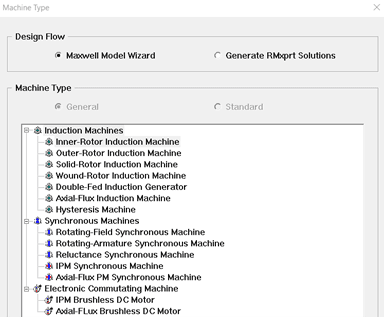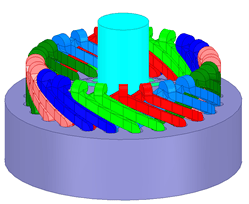The electric propulsion system has drawn more and more attention in the last decade. There has been a lot of development of the electric machines which are used in automotive and aerospace. It is essential for engineers to develop electric machines with high efficiency, high power-density, low noise and cost.
Therefore, simulation tools are needed to design the electric machines that can meet the requirement. The product launching time can be reduced significantly with the help of the simulation tools. The design process of electric machine involves the area of Electromagnetics, Mechanical, Thermal and Fluids. This makes Ansys the perfect tool for designing electric machines as it is a multi-physics simulation platform. Ansys offers a complete workflow from electromagnetics to thermal and mechanical which provides accurate and robust designs for electric machines.
To design high performance, more compact and reliable electric machines, design engineers can start with three Ansys tools: RMxprt, Maxwell and Motor-CAD. The capabilities and differences of these three tools will be compared and discussed.
1. Ansys RMxprt
Ansys RMxprt is a template-based tool for electromagnetic designs of electric machines. It covers almost all of the conventional radial types of electric machines. Starting from Ansys 2020R2, some axial types have also been included in RMxprt (IM, PMSM, BLDC).

Users only need to input the geometry parameters and materials for the machines. The performance data and curves can be obtained for different load types. Since RMxprt uses analytical approaches, it can generate results very fast. It is also capable of running fast coupling/system simulations with Simplorer/Twin Builder. Ready-to-run Maxwell 2D/3D models can be created directly from RMxprt automatically.
2. Ansys Maxwell
Ansys Maxwell is a FEA simulation tool for low-frequency electromagnetic applications. Maxwell can solve static, frequency-domain and time-varying electromagnetic and electric fields. The Maxwell applications can be but not limited to electric machines, transformers, sensors, wireless charging, busbars, biomedical, etc.
Unlike RMxprt which uses analytical method, Maxwell uses the FEA approach which allows it to do high accuracy field simulations. Engineers can either import the geometry or create their own models in Maxwell. Therefore, there is no limit of types of machines that can be modeled in Maxwell. It can model all types of electromagnetic rotary devices such as multi-rotor and multi-stator designs.

Maxwell can do more detailed electromagnetic simulations for electric machines, for example, the demagnetization of the permanent magnets, end winding simulations and magnetostrictive effects. With Maxwell, engineers are able to run parametric sweep for different design variables and to do optimizations to achieve the optimal design. Maxwell is also capable of creating equivalent circuit extraction (ECE) models. The ECE is one of the reduced order modelling (ROM) techniques, which automatically generates an efficient system-level model. There are several Ansys customization toolkit (ACT) available for Maxwell to quickly create efficiency map and simulate impact of eccentricity. Furthermore, Maxwell can be coupled with Ansys Mechanical/Fluent/Icepak to do thermal and mechanical analysis.
3. Ansys Motor-CAD
Ansys Motor-CAD is suitable to make design decisions in early design phase of electric machines. It includes four modules: electromagnetic, thermal, lab and mechanical. Motor-CAD can perform multiphysics simulations of electric machines across the full torque-speed range. Motor-CAD uses a combination of analytical method and FEA, and it can quickly evaluate motor topologies and optimize designs in terms of performance, efficiency and size.
Motor-CAD is capable of simulating the radial types of electric machines. With its lab module, it can do the duty cycle simulations to analyze electromagnetic, mechanical and thermal performances of electric machines. The thermal module is a standard tool in industry which can provide fast thermal analysis with insight of each thermal node, pressure drop, losses. Motor-CAD mechanical module uses 2D FEA to calculate the stress and deformation. Engineers can also manually correlate the models in Motor-CAD based on the manufacturing impacts or testing data.

Motor-CAD can provide links to Ansys Maxwell, Mechanical, Icepak and Fluent for more detailed analysis in the later phases of motor designs.
- What to use?
RMxprt and Motor-CAD both can handle most of the radial types of electric machines. RMxprt can also model some conventional axial flux machines. RMxprt can purely model the electromagnetic performance of the machines, while Motor-CAD can simulate electromagnetic, thermal and mechanical performances.
Maxwell can simulate any types of machines (radial, axial, linear, hybrid, etc.) as it can import or draw any geometry. Both static and transient analysis can be conducted in Maxwell.
- When to use?
RMxprt and Motor-CAD are most suitable in the early design stages of the electric machines. Engineers can get fast results about the machine performance and sizing which can be used as a guideline in the later design phase.
Maxwell can be used in the early design stages for more advanced types of electric machines as well. Maxwell is also capable of doing more detailed electromagnetic designs in the later stage and can be used to do system-level transient-transient co-simulation (coupled with Ansys Simplorer/Twin Builder). More detailed geometries, advanced materials and complex electromagnetic phenomenon can be modeled in Maxwell. In the final stages of running more advanced CFD and NVH analysis, Maxwell can be linked with Ansys Fluent/Icepak/Mechanical to ensure the design robustness of the machines before going into prototyping/production.
- Who can benefit?
RMxprt and Motor-CAD do not require strong FEA simulation skills as no boundary conditions or solution domain need to be set. Engineers with basic knowledge of electric machines can get familiar with the tools and get results very quickly.
Maxwell requires users to setup the mesh, boundary and excitations as it uses the FEA method. Engineers will need to acquire not only the basic concepts of machines but also some FEA simulation skills in order to get more reasonable results.
Summary
RMxprt: It is a template-based tool for initial electric machine designs which uses analytical analysis approach.
Maxwell: It uses FEA approach model both 2D and 3D models. It is capable of simulating either simple or mode advanced electromagnetics in electric machines.
Motor-CAD: It is suitable for initial machine designs which uses analytical and FEA methods. It can do electromagnetic, thermal and initial mechanical analysis.
If you would like more information related to this topic or have any questions, please reach out to us at info@padtinc.com.


















